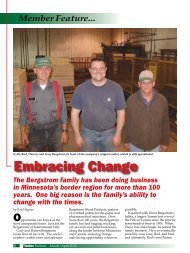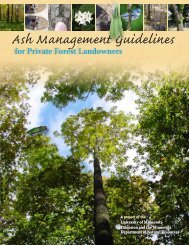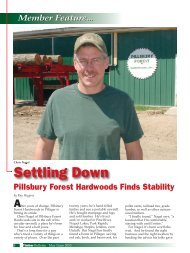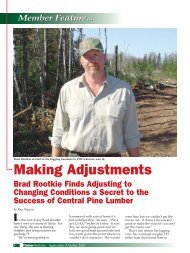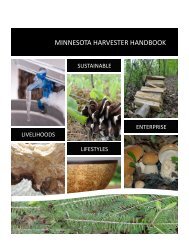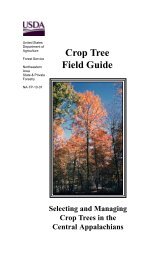Ash Management Guide for Private Forest Landowners
Ash Management Guide for Private Forest Landowners
Ash Management Guide for Private Forest Landowners
Create successful ePaper yourself
Turn your PDF publications into a flip-book with our unique Google optimized e-Paper software.
Chapter 1A History of Minnesota’s<strong>Ash</strong> ResourceGLOSSARYpaleoscientist: Scientists whostudy organisms of the past.Historic Abundance and Change inAbundance of <strong>Ash</strong> in MinnesotaThe history of ash in Minnesota is“old as dirt” – literally. Black ash wasamong the hardy pioneers to occupyfresh soil while glacial ice slowly meltedfrom the landscape some 16,000 to11,500 years ago. We know this becauseblack ash pollen is preserved along withthe pollen, wood, and leaves of othertrees in the oldest sediments of ourlakes. The assemblage of plant fossilsincludes abundant remains of spruce,with lesser amounts of ash, tamarack, fir,sage, ragweed, grasses, and sedges.Most paleoscientists agree that thisassemblage of fossil plant communitieshas no analogue in the modern vegetationof North America. Even where wehave glaciers, we don’t see this particularcombination of plants. This suggests thatthe climate of the late-glacial period inMinnesota and the American Midwest,was unique to that time. Ice cores fromGreenland tell us that the temperaturefluctuated during that time; scientistsdebate about the strength of seasonality– but everyone agrees that it was wet.It is no stretch <strong>for</strong> a botanist to imaginespruce, black ash, tamarack, fir, grasses,and sedges occurring in wet habitatsbecause they occur in such places today.The amount of ash pollen in late glacialsediments (~10-15 percent) is the mostthat we see in any lake sediments fromMinnesota. When Minnesota was icefreeand experiencing a much warmerclimate (the modern Holocene Epoch),other native trees eventually migratedinto the state. Competition with thesenew species, the maturation of soils, andconsiderably drier conditions helped todiminish ash populations. Sedimentsyounger than about 11,000 years havelittle ash pollen, but it is steadily present.Apparently, the wet <strong>for</strong>est niche that favorsash has been a stable component ofMinnesota’s landscape since the glacierswere here. Be<strong>for</strong>e the arrival of EAB andconcern of global warming, the 11,000-year pollen record assured Minnesotan’sof an ash resource.White settlers have significantly impactedash populations during the courseof settlement and agricultural developmentof Minnesota. When settlers firstShown here is a Floodplain<strong>Forest</strong>, referred to in the NativePlant Community classificationas an “FF.”Photo: Michael Lee8



